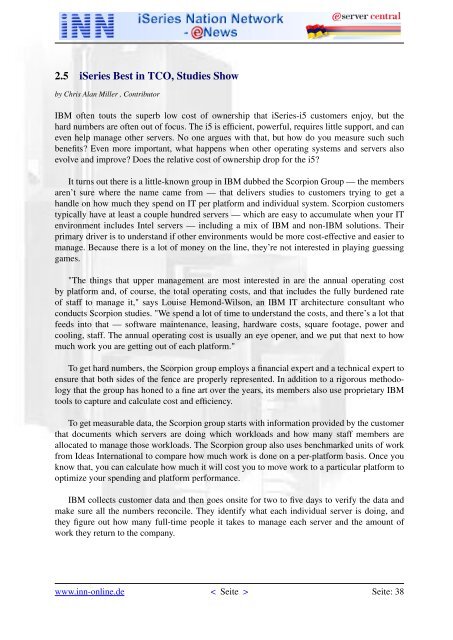iNN - eNews - SSS-Software
iNN - eNews - SSS-Software
iNN - eNews - SSS-Software
Sie wollen auch ein ePaper? Erhöhen Sie die Reichweite Ihrer Titel.
YUMPU macht aus Druck-PDFs automatisch weboptimierte ePaper, die Google liebt.
2.5 iSeries Best in TCO, Studies Show<br />
by Chris Alan Miller , Contributor<br />
IBM often touts the superb low cost of ownership that iSeries-i5 customers enjoy, but the<br />
hard numbers are often out of focus. The i5 is efficient, powerful, requires little support, and can<br />
even help manage other servers. No one argues with that, but how do you measure such such<br />
benefits? Even more important, what happens when other operating systems and servers also<br />
evolve and improve? Does the relative cost of ownership drop for the i5?<br />
It turns out there is a little-known group in IBM dubbed the Scorpion Group — the members<br />
aren’t sure where the name came from — that delivers studies to customers trying to get a<br />
handle on how much they spend on IT per platform and individual system. Scorpion customers<br />
typically have at least a couple hundred servers — which are easy to accumulate when your IT<br />
environment includes Intel servers — including a mix of IBM and non-IBM solutions. Their<br />
primary driver is to understand if other environments would be more cost-effective and easier to<br />
manage. Because there is a lot of money on the line, they’re not interested in playing guessing<br />
games.<br />
"The things that upper management are most interested in are the annual operating cost<br />
by platform and, of course, the total operating costs, and that includes the fully burdened rate<br />
of staff to manage it," says Louise Hemond-Wilson, an IBM IT architecture consultant who<br />
conducts Scorpion studies. "We spend a lot of time to understand the costs, and there’s a lot that<br />
feeds into that — software maintenance, leasing, hardware costs, square footage, power and<br />
cooling, staff. The annual operating cost is usually an eye opener, and we put that next to how<br />
much work you are getting out of each platform."<br />
To get hard numbers, the Scorpion group employs a financial expert and a technical expert to<br />
ensure that both sides of the fence are properly represented. In addition to a rigorous methodology<br />
that the group has honed to a fine art over the years, its members also use proprietary IBM<br />
tools to capture and calculate cost and efficiency.<br />
To get measurable data, the Scorpion group starts with information provided by the customer<br />
that documents which servers are doing which workloads and how many staff members are<br />
allocated to manage those workloads. The Scorpion group also uses benchmarked units of work<br />
from Ideas International to compare how much work is done on a per-platform basis. Once you<br />
know that, you can calculate how much it will cost you to move work to a particular platform to<br />
optimize your spending and platform performance.<br />
IBM collects customer data and then goes onsite for two to five days to verify the data and<br />
make sure all the numbers reconcile. They identify what each individual server is doing, and<br />
they figure out how many full-time people it takes to manage each server and the amount of<br />
work they return to the company.<br />
www.inn-online.de < Seite > Seite: 38


